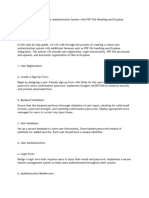0% found this document useful (0 votes)
21 views2 pagesImplementing A Single Sign
The document provides recommendations for choosing a tech stack and backend infrastructure for implementing a Single Sign-On (SSO) web application. It suggests using React or Vue.js for the frontend, Node.js or Django for the backend, implementing JWT for authentication, and considering authentication services like Firebase or Auth0. It also recommends hosting the application on a cloud platform like AWS or Azure, containerizing it with Docker/Kubernetes, and using a web server like NGINX.
Uploaded by
ojangoh2Copyright
© © All Rights Reserved
We take content rights seriously. If you suspect this is your content, claim it here.
Available Formats
Download as PDF, TXT or read online on Scribd
0% found this document useful (0 votes)
21 views2 pagesImplementing A Single Sign
The document provides recommendations for choosing a tech stack and backend infrastructure for implementing a Single Sign-On (SSO) web application. It suggests using React or Vue.js for the frontend, Node.js or Django for the backend, implementing JWT for authentication, and considering authentication services like Firebase or Auth0. It also recommends hosting the application on a cloud platform like AWS or Azure, containerizing it with Docker/Kubernetes, and using a web server like NGINX.
Uploaded by
ojangoh2Copyright
© © All Rights Reserved
We take content rights seriously. If you suspect this is your content, claim it here.
Available Formats
Download as PDF, TXT or read online on Scribd
/ 2





















































































